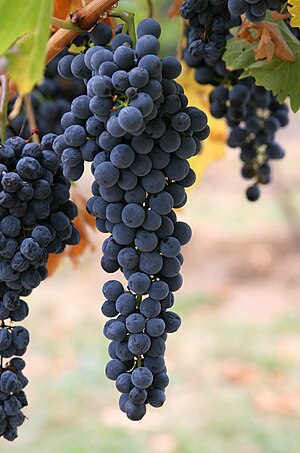Grape
Introduction[edit | edit source]
Grapes are a type of fruit that grow on vines in clusters. They are known for their sweet, juicy flavor and are often used to make wine, juices, jams, and jellies. The scientific name for the common grapevine is Vitis vinifera.
Description[edit | edit source]
Grapes come in a variety of colors, including green, red, and purple. They are round or oval in shape and have a smooth, shiny skin. Grapes contain seeds or are seedless, depending on the variety. The flesh of the grape is juicy and sweet, with a slightly tart taste. Grapes grow in clusters on vines that can reach up to 100 feet in length.
Cultivation[edit | edit source]
Grapes are grown around the world in temperate climates. They require well-draining soil and plenty of sunlight. Grapes are typically harvested in the late summer or early fall. Grapes can be eaten fresh or used in a variety of recipes, including salads, desserts, and main dishes. They are also commonly used to make wine.
Varieties[edit | edit source]
There are thousands of varieties of grapes, each with their own unique flavor and characteristics. Some popular varieties include:
Thompson Seedless: a green grape that is seedless and sweet. Concord: a purple grape that is often used to make grape juice. Red Globe: a large, red grape that is sweet and juicy.
Health benefits[edit | edit source]
Grapes are a good source of vitamins and minerals, including vitamin C, vitamin K, and potassium. They are also high in antioxidants, which can help protect against cell damage and reduce the risk of chronic diseases such as cancer and heart disease.
Subspecies[edit | edit source]
There are several subspecies of the common grapevine (Vitis vinifera):
V. v. vinifera: includes most wine and table grape varieties. V. v. sylvestris: the wild grapevine, native to the Mediterranean region. V. v. sativa: a subspecies of V. vinifera that is specifically cultivated for wine production. V. v. labrusca: native to North America, this subspecies is commonly used in grape juice production.
History[edit | edit source]
The cultivation of grapes dates back thousands of years to ancient civilizations such as the Egyptians and Greeks. The cultivation and production of wine from grapes has been a significant part of human history and culture for centuries. Grapes were introduced to the Americas by European settlers in the 16th century, and are now widely cultivated in North and South America.
Cultural significance[edit | edit source]
Grapes have played a significant role in many cultures throughout history. In Greek mythology, grapes were associated with the god Dionysus and were a symbol of fertility and abundance. Grapes have also been used in religious ceremonies, such as in the Christian sacrament of Communion.
In addition, grapes have been the subject of many works of art, literature, and music. The painting The Vine by Vincent van Gogh depicts a vineyard in autumn, while the novel The Grapes of Wrath by John Steinbeck tells the story of a family's struggle during the Great Depression. The song Purple Haze by Jimi Hendrix contains the line "excuse me while I kiss the sky", which is often misheard as "excuse me while I kiss this guy" - a phenomenon known as a mondegreen.
Usage[edit | edit source]
Grapes are a versatile fruit and can be eaten fresh or used in a variety of recipes. They are commonly used in salads, desserts, and main dishes, as well as in the production of juice, jelly, and jam. Grapes are also a key ingredient in the production of wine.
Grapevine pests and diseases[edit | edit source]
Like any crop, grapevines are susceptible to a number of pests and diseases that can impact their growth and health. Common grapevine pests include grape phylloxera, grape berry moth, and grapevine mealybug. Grapevine diseases include powdery mildew, downy mildew, and black rot. Vineyard managers use a variety of techniques to control pests and diseases, including the use of natural predators, pesticides, and fungicides.
Conclusion[edit | edit source]
In conclusion, grapes are a popular fruit that are cultivated around the world for their sweet, juicy flavor. They are an important ingredient in a variety of dishes, as well as in the production of wine, juice, and other products. Grapes have played a significant role in human history and culture, and continue to be an important part of many cultures and traditions today.
References[edit | edit source]
See also[edit | edit source]
External links[edit | edit source]
![]() Data related to Vitis vinifera at Wikispecies
Data related to Vitis vinifera at Wikispecies
- Portal:Food | Glossary of healthy eating | UK Foods | US Foods | Dietary Supplements | Nutrition values of foods
- Encyclopedia of nutrition | Calorie Finder | Nutrition Database | Glycemic Index of Foods | Protein rich foods list
External links[edit source]
Navigation: Wellness - Encyclopedia - Health topics - Disease Index - Drugs - World Directory - Gray's Anatomy - Keto diet - Recipes
Search WikiMD
Ad.Tired of being Overweight? Try W8MD's physician weight loss program.
Semaglutide (Ozempic / Wegovy and Tirzepatide (Mounjaro) available.
Advertise on WikiMD
WikiMD is not a substitute for professional medical advice. See full disclaimer.
Credits:Most images are courtesy of Wikimedia commons, and templates Wikipedia, licensed under CC BY SA or similar.
Contributors: Admin, Kondreddy Naveen, Spt


